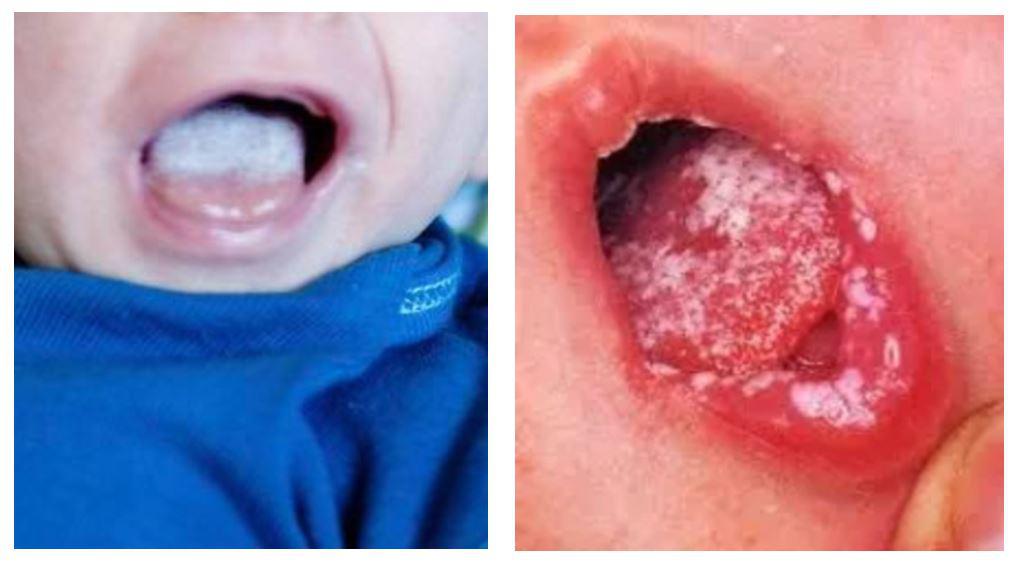[HIMBA] WHITE TONGUE... Milk?... Thrush?

(Left) Picture A (Right) Picture B
HIMBA: Can you often see a white coating on your baby's tongue? Mothers are often unsure what this is and how to treat it. Lets look at two pictures...
Picture A. Milky tongue
-This is NORMAL. It does not need regular cleaning. If you would like to clean it you can wipe gently, sweeping over the tongue with a damp gauze (using cooled preboiled water)- this is enough to remove some of the milk film but breastfed babies do not need regular tongue cleaning (if there are no teeth) as breast-milk contains properties to protect the mouth. Formula fed infants may benefit more from a gentle wipe/oral clean. This is not routinely recommended yet but some dentists suggest an oral gauze wipe daily.
- Milky tongue looks like a white tongue that often has a clean area at the tip of the mouth. It may be more of a strip and doesn’t affect gums and other areas of the mouth.
-Milk tongue is caused from the baby not taking the breast or bottle deeply into the mouth. Many times, the milk film will dissolve an hour after feeds- but sometimes it is harder to remove the milk and this does not necessarily mean it is thrush.
Picture B. Oral Thrush.
This is affecting the lips, gums and tongue and is patchier in appearance. The tongue is also more red raw and if you try to gently wipe this, it would be hard to remove and if it did come off, a red, raw tongue may be seen underneath.
Why does my baby have thrush?
Thrush is a yeast infection and it is common in babies. It may have originated from:
- Birth: Vaginal thrush can pass onto your baby
-Antibiotic use or steroids: Following these the normal bacteria can be disturbed and yeast infections are able to establish easily.
-Low immunity or conditions such as anaemia, diabetes or vitamin deficiencies.
-Breastfeeding concerns such as cracked nipples. If positioning and attachment is not effective and the nipple is cracked it is vulnerable to bacteria. As the breast/nipple is a warm and moist area, yeast infections can harbour.
What to do if it is thrush?
- Many babies require treatment for thrush but mild cases can sometimes be closely monitored to see if they go by themselves- mild cases will resolve between 3-8 weeks but if feeding is affected, or it is worsening then treatment will be needed.
-If a mother is breastfeeding, treatment for both mother and baby is required as it will be passed between the breast and mouth.
- Sterilising bottles, breast pump equipment, dummies etc is vitally important to ensure that the yeast infection is not going to remain on these objects and after treatment, restart the infection.
-Good hand hygiene when nappy changing and feeding is also important.
-Mothers with thrush may have painful breastfeeds. Both breasts are likely to be affected and nipples often present as red, sore, itchy or flaky. Sharp pains that are felt throughout the feed and for an hour afterwards are associated with thrush.
-Check that your baby does not have a nappy fungal rash too.
-Change nursing pads regularly and expose your breasts to air. Wash bras at high temperatures.
-Probiotics and a diet low in sugar, yeast and dairy can help
-Wash with a non-antibacterial soap as antibacterial soaps also kill good bacteria which are needed to keep yeast at bay
-Swabs are not often helpful - research suggests many babies are colonized with thrush anyway and are not always symptomatic. Likewise mothers nipples can also be colonized without symptoms. Swabs also have a low detection rate. It is now good practice to assess by appearance and history and if treatment isnt working to consider further investigation.
Once treatment begins, symptoms usually begin to improve after 2-3 days.
Most importantly, you do not need to stop breastfeeding. Get support and get treatment.
https://milkmatters.org.uk/2017/03/20/really-thrush-babys-tongue/
https://breastfeeding.support/treatments-sore-nipples/
https://www.unicef.org.uk/babyfriendly/support-for-parents/thrush/
https://www.llli.org/breastfeeding-info/thrush/
Author: Abigail Laurie Registered Midwife and Registered Specialist Public Health Nurse from the United Kingdom
 We use cookies on this website to enhance your user experience
We use cookies on this website to enhance your user experience